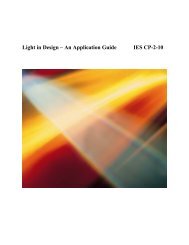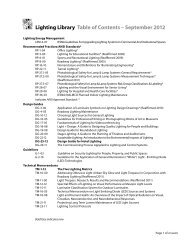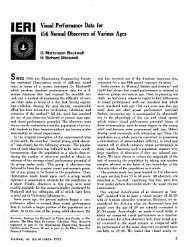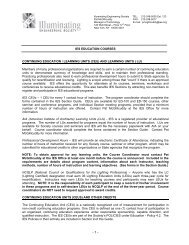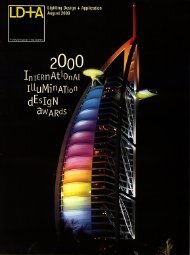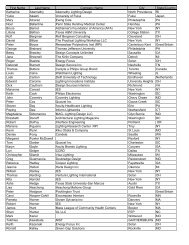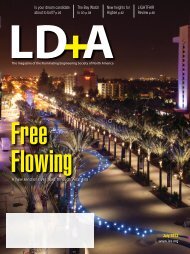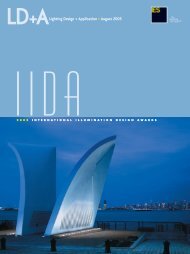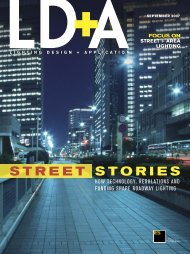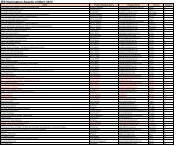light products - Illuminating Engineering Society
light products - Illuminating Engineering Society
light products - Illuminating Engineering Society
You also want an ePaper? Increase the reach of your titles
YUMPU automatically turns print PDFs into web optimized ePapers that Google loves.
LIGHTING FOR QUALITY<br />
The Shadow Knows<br />
Doug Paulin, LC<br />
YES,THIS IS A PERIODICAL<br />
of the <strong>light</strong>ing arts and sciences in<br />
North America. But I devote this<br />
column to shadows. Plural. Shadows<br />
are so important for our vision, and<br />
not just the simple silhouette, often<br />
referred to as “negative contrast” in<br />
roadway conversations. (Have you<br />
ever noticed how we have the habit<br />
of taking a nice simple word that<br />
everyone understands [silhouette]<br />
and inventing a “<strong>light</strong>ing term” for it<br />
[“negative contrast”]).<br />
Back to shadows. My first encounter<br />
with shadows was in a<br />
photo studio.We were shooting new<br />
product for catalogs and spec sheets.<br />
We paid attention to shadows and<br />
reflections and fiddled with other<br />
things that can make or break a good<br />
catalog photo until we wanted to<br />
scream.But shadows are the visual<br />
cues that tell us that the object in the<br />
two-dimensional photo is actually<br />
three-dimensional. The photographer<br />
would often take the first 4 x 5<br />
Polaroid snap from the camera and<br />
say “Yep, it looks like a hubcap!” But<br />
after he adjusted the <strong>light</strong>ing to<br />
accentuate the depth and shape, it<br />
would look like a <strong>light</strong>ing fixture.<br />
Modeling is a technique of creating<br />
varying shades of brightness, or,<br />
should I say, varying darkness of<br />
shadows.The modeled effect comes<br />
from two or more sources, hitting<br />
the three-dimensional object from<br />
different angles and different intensities.<br />
This doesn’t mean that the<br />
sources themselves have to be different;<br />
one can be farther away from<br />
the other(s).<br />
Playing Tricks<br />
This brings us to the “trick” I use<br />
most often when measuring illuminance<br />
in the field.Pay attention to the<br />
shadows—not just the shadow of<br />
your head on the <strong>light</strong> meter! Look at<br />
your own shadows on the floor.<br />
When your own shadows are equally<br />
dark, you are probably equidistant from<br />
each of the <strong>light</strong> sources.To make sure,<br />
move back and forth a few steps<br />
either way and watch one shadow<br />
get darker, and the other <strong>light</strong>er.Why<br />
is this important Because the midpoint<br />
between two fixture locations<br />
could be a point of minimum <strong>light</strong><br />
level. It then follows that a point<br />
Figure 1<br />
Figure 2<br />
between four fixtures should give you<br />
four shadows of equal darkness. (I<br />
almost typed “equal density” which is<br />
more exact, but not as easy to read.)<br />
Have you ever “counted” the shadows<br />
each football player makes on<br />
the field This tells you how many<br />
sports floods are aimed at that point,<br />
doesn’t it<br />
Another example: A decorative<br />
street <strong>light</strong>ing project in downtown<br />
Madison,WI, uses semi-cutoff decorative<br />
luminaires. A colleague pointed<br />
out that there couldn’t have been<br />
much horizontal <strong>light</strong> generated<br />
because the street<strong>light</strong> across the<br />
boulevard was able to cast a shadow<br />
of the fixture and pole on an adjacent<br />
wall (Figure 1). I studied this<br />
installation in person and couldn’t<br />
help myself from creating another<br />
shadow on the wall with my arm.<br />
The <strong>light</strong> across the boulevard created<br />
a shadow of my arm on the<br />
wall, as expected, but where my<br />
arm-shadow crossed the pole-shadow,<br />
you could see that the intersection<br />
of the two shadows was darker<br />
than the pole-shadow (Figure 2).<br />
The analysis My arm-shadow blocked<br />
the <strong>light</strong> from the near fixture, as<br />
well as <strong>light</strong> from the one farther<br />
away, and while the pole-shadow<br />
was there, it was not as dark because<br />
some of the high angle <strong>light</strong> was<br />
washing some of it out.Again, more<br />
than one shadow can tell you so<br />
much about what is going on with<br />
the <strong>light</strong>, or <strong>light</strong>s.<br />
So pay attention to the shadows.<br />
Especially if you are dealing with<br />
multiple sources and locations of the<br />
luminaires. Shadows can give you the<br />
contrast necessary for good visualization<br />
of the scene, but they can be<br />
a good analysis tool also.<br />
Doug Paulin, LC, is currently with<br />
<strong>light</strong>ing rep firm Packerland Lighting<br />
Sales, Inc., Egg Harbor,WI.Throughout<br />
his career, he’s worked as an independent<br />
<strong>light</strong>ing designer and has also held<br />
positions ranging from product manager<br />
and marketing manager for manufacturers<br />
including Ruud Lighting,<br />
Lithonia Lighting, Cooper Lighting and<br />
Thomas Day-Brite Lighting.<br />
December 2005 LD+A 17



